Dolphin Fleet Naturalist Notebook June 5th to 12th
On June 5th we sailed out into Cape Cod Bay with excellent whale sightings conditions, low winds and calms seas. We observed 13 humpbacks and 3 finback whales. Many of the humpbacks were engaging in active behaviors such as lobtailing, breaching and flipper slapping. We identified Ventisca, Thread, Mayo, Salt, Cardu, Charger, Blackhole and calf, Anvil and calf, Glo and calf and Bolide and calf. Glo and Bolide’s calves were going on high fluking dives and breaching. Breaching takes an incredible amount of strength and energy, so it is always impressive to see such lively behaviors from young whales. Charger was engaging in a different active behavior called lobtailing, whereby Charger was standing on its head with its tail flukes protruding vertically out of the water and was slapping the water with its flukes making large splashes. Although scientists are unsure why whales exude such behaviors, they speculate that it may be a form of communication as lobtailing generates a great deal of noise. Sometimes seabirds will confuse this behavior for a similar feeding behavior called kick feeding. When humpbacks are feeding at the surface is it common for seabirds to aggregate around the whale in hopes that they might catch a fish that the whales have scared up to the surface.
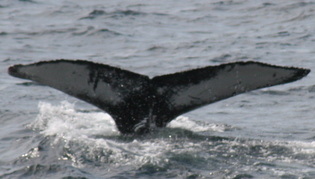
Charger
We headed for Stellwagen Bank on May 6th with fog, light wind and glassy calm seas. Despite the less than ideal whale sightings conditions, we observed 12 humpback whales and 2 gray seals. We identified Wizard, Hazard, and Palette and calf. To our surprise, all five humpbacks became curious of our boat. While we stayed at location, the whales took turns swimming around our boat, allowing us to get within a few feet. As the whales took deep breaths and exhaled we became completely covered in the whale’s breath. It appears as though humpbacks curiosity is not new, as historical accounts from 1658 describe similar behaviors, as humpbacks would accompany French explorers, making them wary of the whale’s intentions. Now knowing that the whales close boat approach was based more on intrigue than anything aggressive, we were able to appreciate the size and beauty of the animals. Towards the end of the trip the whales changed their behaviors as they began flipper slapping, lobtailing and tail breaching.
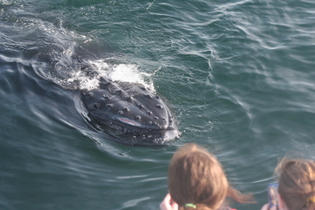
Curious Humbpack
On June 7th we had ideal whale watching conditions, with light winds and calm seas. While traveling to Stellwagen Bank we sighted 7-8 humpback whales. One of the humpbacks was Ventisca, a female first seen in 2001. Ventisca quickly became interested in our boat giving us a close boat approach! As she swam around us we were able to observe her unusual pigmentation. Although it is common for Atlantic humpbacks to have white pigmentation on their flippers and ventral flukes, Ventisca’s all white dorsal fin and dorsal flukes are unique. With an excess of white pigmentation it is no surprise that her name means blizzard in Spanish. Later in the day while on the South West Corner of Stellwagen Bank, we observed 14 humpback whales and 1 finback whale. Many of the humpbacks were displaying elaborate feeding strategies, such as bubble clouds and nets.
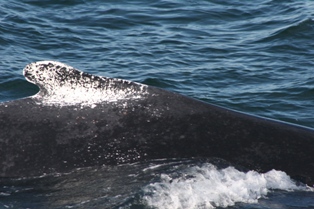
Ventisca (dorsal fin)
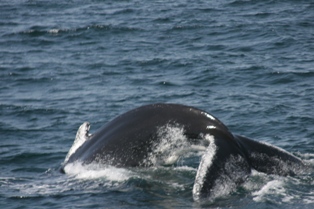
Ventisca (dorsal flukes)
We left the harbor on June 8th with optimal whale sighting conditions, light wind and glassy-calm seas. While on the South West Corner of Stellwagen Bank we observed 23 individual humpback whales and identified Tracer. The whales were demonstrating a variety of behaviors, including fluking dives, bubble feeding and kick feeding. Later that day we observed 12-16 humpbacks off of Peaked Hill, including Hancock, Seal, Zeppelin and Ventisca. Because most humpbacks reach sexual maturity between 5 and 6 years of age, is it likely that all identified humpbacks were adults as the youngest whale was 18 years old (Hancock). The humpbacks displayed a myriad of active behaviors, including, spinning breaches, lobtailing, flipper slapping and close boat approaches!
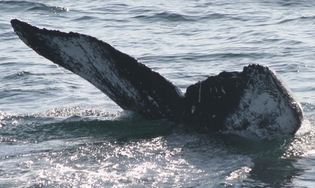
Hancock
We steamed out to the Southern Edge of Stellwagen Bank on June 9th with grey skies and calm seas. We observed 16-17 humpback whales and identified Mostaza, Eruption, Citation, Canopy and Jabiru. A diversity of behaviors were observed, with tail breaches, flipper slapping, close boat approaches and lobtailing. Several of the same humpbacks were sighted in the afternoon, however, their behaviors had changed from active playful behaviors to feeding behaviors. Mostaza, Citation and Canopy were all sub-surface feeding, whereby the whales had located a prey patch of sand lance below the surface of the water. When whales are feeding sub-surface you can often see sea birds such as common terns and laughing gulls hovering in the area, waiting for the whales to scare the fish up to the surface from below. Terns are often referred to as “strikers” because of their extraordinary ability to dive while feeding on schooling fish. The birds use their telescopic eyes while hovering over their prey and then dive into the water.
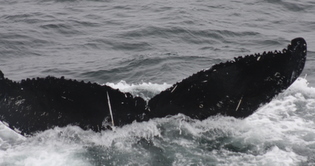
Canopy
With bright haze and moderate seas we sailed out of Provincetown harbor on June 10th. While on our way to Peaked Hill we observed 16 individual humpback whales. As a general trend, the whales appeared to be conducing high fluking dives, although one whale became curious of our boat. We identified Trident, Wizard, Tongs, Hancock, Rune and Pinpoint. Trident and Wizard both demonstrated signs of curiosity as they traveled around our boat, diving only a few feet below us and popping up on either side of the boat. Rune and Pinpoint, however, were resting at the surface. Because whales cannot fully sleep as they would likely drown, they rest near the surface lying almost motionless. At firs-glance the whales often resemble logs bobbing up and down at the sea surface. In the afternoon, the whales fluking dives continued, however, Nuages, Binary and calf, Mars and calf, Bolide and calf and Springboard and calf demonstrated a variety of active behaviors, including breaching, flipper slapping and lobtailing. Perhaps most impressive, was Mars’s breaching calf. It requires a tremendous amount of energy and strength to breach, so it is always impressive to see young whales display such active behaviors.
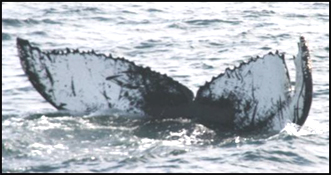
Trident
On June 11th we sailed out to Peaked Hill with rain, light wind and moderate seas. We observed 16 humpback whales, 1 finback whale, 5 basking sharks and 3 grey seals. Basking sharks are one of the largest sharks, second to the whale shark. They can reach up to 40 feet in length, although typical lengths are between 20 and 26 feet. Although basking sharks are sometimes mistaken for great white sharks they have several distinguishing characteristics, for instance, basking sharks are filter-feeders. These sharks make a living by feeding on almost microscopic organisms called zooplankton. Unfortunately, many of the basking sharks seen off Cape Cod have scars on their bodies, some from lampreys and cookie cutter sharks and others from vessel strikes. Because basking sharks often moving slowing, feeding on plankton at the surface and are not known to avoid ships, they are especially prone to vessel strikes.
After leaving the basking sharks around Long Point Lighthouse, we encountered several humpback whales including Ivory, Whisk, Draco, Canopy, Ventisca and Glo and calf. Many of the whales were going on high-fluking dives, however, towards the end of our trip the whales began feeding as they found large schools of sand lance. Glo was lunge and kick feeding and others were making bubble clouds and dragging. Unfortunately, this feeding frenzy was short lived, as the whales soon changed behaviors. Towards the end of the day the whales began to display active behaviors such as flipper slapping, breaching and lobtailing.
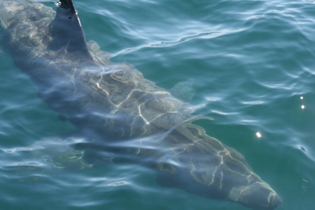
Basking Shark
On June 12th we sailed out to Race Point Lighthouse with less than ideal whale sightings conditions as we had limited visibility due to fog. Despite the challenging conditions, we observed 7 humpback whales and 2 harbor seals. Some of the humpbacks appeared to be traveling randomly, which may have been indicative of foraging, while others were maintaining a linear path of travel. Because whales spend approximately 10% of their time at the surface, it is generally difficult to determine sub-surface behaviors, often leaving whales true behavior a mystery.





